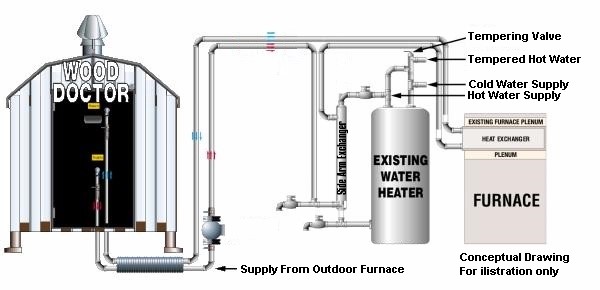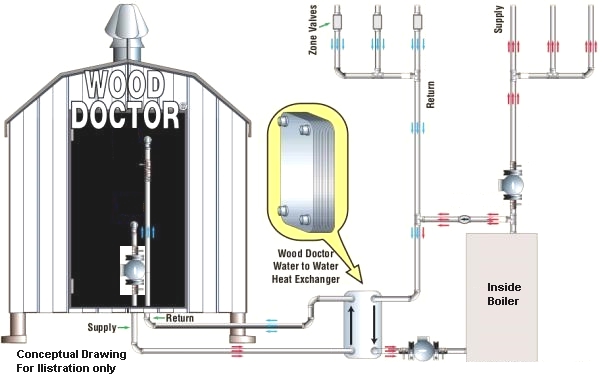The outdoor hot water furnace is usually centrally located and used to to heat multiple buildings - house, garage, shop, barn, hot tub, swimming pool, grain drying, etc.
A typical outdoor boiler installation is the pumping of heat transfer fluid (recommended minimum 30% propylene glycol solution) from the outdoor boiler via insulated piping buried underground to the building to be heated.
The heat transfer fluid then typically goes through a side arm heat exchanger which is mounted on the existing hot water tank to heat the domestic hot water and then
goes through a radiator is installed in the existing forced air furnace that is controlled by a separate thermostat.
The conceptual drawing below depicts a "Typical Residential Furnace & DHWT" connection to an outdoor central heating system.

Your existing domestic hot hater tank domestic hot water tank and furnace as an automatic back up system to the outdoor hot water furnace, in the event it goes out for whatever reason.
The conceptual drawing below depicts a "Typical Residential Boiler" connection to an outdoor central heating system.

The above conceptual drawing shows how easy to connect the outdoor boiler to any existing boiler or hydronic heating system. (The plate exchangers and pumps need to be properly sized to match your indoor heating loads and the required hydronic system the delta T)
There are many variations from the above described "typical heating systems", the most common would be adding slab heat to your basement and garage concrete floors.
The conceptual drawing below depicts a "Typical Residential Furnace & DHWT" connection to an outdoor central heating system.

Your existing domestic hot hater tank domestic hot water tank and furnace as an automatic back up system to the outdoor hot water furnace, in the event it goes out for whatever reason.
The conceptual drawing below depicts a "Typical Residential Boiler" connection to an outdoor central heating system.

The above conceptual drawing shows how easy to connect the outdoor boiler to any existing boiler or hydronic heating system. (The plate exchangers and pumps need to be properly sized to match your indoor heating loads and the required hydronic system the delta T)
There are many variations from the above described "typical heating systems", the most common would be adding slab heat to your basement and garage concrete floors.
No Utility Bills Inc.
All rights reserved.
Last modified: 10/19/24



